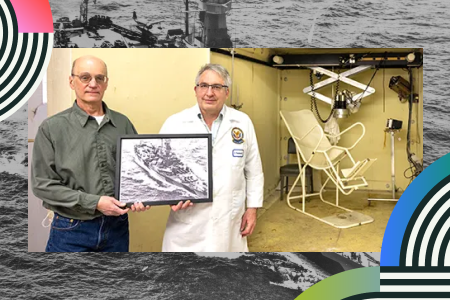Winner Spotlight
The Battleship in Building Oneby Dept. of Veterans Affairs

VA News, created by the US Department of Veteran Affairs, is an online source for news stories pertaining to the department, the veterans they serve and their families. The article “The Battleship in Building One” won the 2023 Award of Excellence: B2B Writing – Feature Article and the 2023 Award of Distinction: Writing – Feature Article. It cleverly recounts how parts of the decommissioned WW2 battleship USS Indiana came to live at the Edward Hines, Jr. VA hospital, and how they were integral to pioneering new treatments for veterans. Read the article below.
May 11, 2022
By Matthew Moeller, public affairs specialist at the Edward Hines, Jr. VA Hospital.
Photos by Louis Washkowiak, a medical support assistant, also at the Edward Hines, Jr. VA Hospital.
For more than 100 years, Edward Hines, Jr. VA hospital has served Chicago-area Veterans.
Although a century of expansion and remodeling has left the sprawling 147-acre campus looking very different from when it first opened in 1921, many lost histories remain tucked away in overlooked boxes, closets and rooms.
But few forgotten memories compare to how 65 tons of the USS Indiana ended up in the hospital’s Building One.
Setting sail in 1942, the USS Indiana was the second of four South Dakota-class battleships commissioned by the U.S. Navy. The ship was designed for faster speeds and higher mobility. The ship served throughout the Pacific theater, cutting its teeth at Guadalcanal and continuing to island-hop until Japan’s surrender in 1945.
After the war, like many Navy vessels, the USS Indiana was decommissioned. For nearly 20 years, it floated mothballed in a California shipyard until its unique characteristics proved instrumental to the emerging science of nuclear medicine.
Iron room needed metal free of man-made radiation
Ervin Kaplan was a Marine Corps Raider who served throughout the Pacific theater during World War II. Kaplan used his G.I. Bill benefits to become a medical doctor, eventually becoming chief of Hines VA’s new Radioisotope Service. Kaplan was a VA pioneer in nuclear medicine. Early in his career, he and his team designed an enormous device capable of detecting extremely low levels of radiation throughout the entire body, which was difficult at the time.

Referred to as “a radiation-free island,” Kaplan’s idea was an iron room, 10 feet long, 8 feet wide and 8 feet high. Inside a person would sit reclined, watching their favorite television programming. Detectors would absorb gamma radiation throughout the body and turn it into flashes of light. Technicians could count and measure the flashes to identify any radiation spikes, according to VA records.
However, Kaplan had a problem. His “island” needed metal free of man-made radiation to make such precise measurements. Thankfully, the Navy had millions of tons ready for scrap floating with their mothballed fleet.
One of the chief reasons for using pre-1945 battleship armor is that such steel, during mining and fabrication, had not been subjected to man-made radioactive fallout (nuclear weapons).
Its metal dating to the 1930s, USS Indiana was perfect
The Navy chopped off six 8-inch-thick armor plates from its gun turret. The Department of Atomic Energy shipped the massive cargo from California to a south-side Chicago foundry for milling. Kaplan’s iron box was built piece by piece atop a specially made 12-foot-thick concrete pad inside of Hines VA’s Building One.
“It creates an environment that predates atomic fallout,” said Paul Kanabrocki, health physicist at Hines VA. “There are other whole-body counters that exist, but you’d be hard-pressed to find one with this type of environment or shielding. It’s never existed as far as I know.”
Kaplan’s iron box was used for more than 40 years at Hines. Early on, the device was primarily employed for research. It served other needs, including analyzing survivors of the 1986 Chornobyl Nuclear Power Plant disaster in modern Ukraine, according to Peter Kelly, a retired Hines health physicist who worked with the device throughout his Hines VA career.
“Unfortunately, we found levels of radiation above normal standards in both individuals,” Kelly noted.
Veteran spent time in iron box watching Cubs game
By the 1990s, newer, smaller equipment was employed throughout the department. Kaplan’s 1966 behemoth was largely used to monitor possible staff exposure to radioactive materials.
“We used it on some occasions if there was ever a fear of internal radiation exposure when I first started working here,” said Dr. Nicholas Friedman, Hines VA Nuclear Medicine section chief. “They tried sticking me in there once. As soon as they shut the door, I started yelling, ‘Get me out of here. I’m claustrophobic,’” he joked.
Kanabrocki was an intern in Hines’ Nuclear Medicine Service in the 1980s and recalled a more pleasant experience behind the box’s 8-inch-thick steel door. “I think I watched the Cubs game,” he said.
Device officially retired in July 1995
Too cumbersome to move, the largely forgotten 65-ton piece of history remains in its original room, locked behind a door.
Although Kaplan’s iron box is now retired, the device holds a long history of service to this nation, just like the USS Indiana that birthed it.
“In a way, it seems very appropriate having part of the USS Indiana at Hines VA,” said James Doelling, hospital director. “The USS Indiana and its crew served our country proudly throughout World War II. Like many Veterans of its era, including Dr. Kaplan, it returned home and served its country in a different way. What better place for part of this Veteran battleship to make its final home than a Veterans Hospital?”